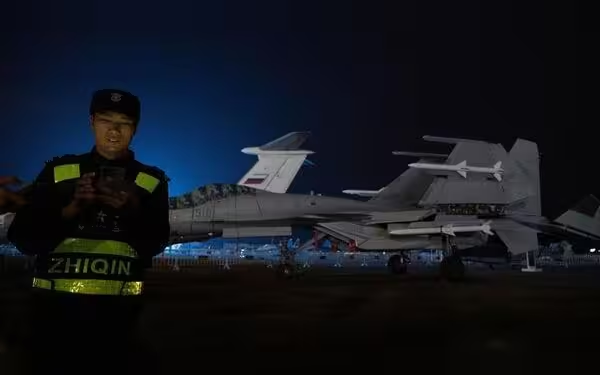Saturday, November 16, 2024 09:26 PM
China Unveils Advanced Military Technology at Zhuhai Airshow
- Debut of China's J-35A stealth fighter.
- Introduction of Jiu Tian drone for swarm technology.
- Showcase of HQ-19 missile system's capabilities.
 Image Credits: menafn
Image Credits: menafnChina showcases cutting-edge military technology, including the J-35A fighter and Jiu Tian drone, at the Zhuhai Airshow.
China's aviation industry is rapidly evolving, showcasing its military prowess at the 15th China International Aviation and Aerospace Exhibition in Zhuhai. This significant event, which commenced on Tuesday, is the largest air show in the country and features a variety of military aircraft, passenger jets, drones, and advanced weapon systems. Many of these technologies are being displayed to the public for the first time, drawing attention from military enthusiasts and foreign businesses alike.
One of the highlights of the air show is the debut of China's newest stealth fighter, the J-35A. This aircraft, which has been in development for over a decade, is designed primarily for air superiority missions but also possesses surface attack capabilities. Unlike the J-20, which is already in service, the J-35A is smaller and lighter, emphasizing stealth. A notable distinction is that while the F-35 is powered by a single large turbofan engine, the J-35A features twin engines, making it more suitable for land operations rather than aircraft carrier use.
Another significant aircraft on display is the J-15T, an upgraded version of China's J-15 carrier-based fighter. This new model includes catapult-launch capabilities, allowing it to operate from China's two existing aircraft carriers, the Liaoning and Shandong, as well as the newer Fujian carrier, which is currently undergoing sea trials. The J-15T participated in China's first dual-carrier drills last month, showcasing its advanced capabilities. Notably, it is equipped with Chinese-made WS-10 turbofans, indicating a shift away from reliance on Russian engines.
In addition to fighter jets, the air show features the HQ-19, a mobile surface-to-air missile system designed for regional interception of ballistic missiles. Each launch system is mounted on an 8x8 wheeled chassis and carries six interceptor missiles. Experts have drawn comparisons between the HQ-19 and the U.S. THAAD-ER system, highlighting its advanced interception capabilities.
Another remarkable innovation is the Jiu Tian, a massive jet-powered unmanned aerial vehicle (UAV) capable of launching swarms of smaller drones for various missions, including reconnaissance and electronic warfare. With a maximum take-off weight of 16 tonnes, the Jiu Tian represents China's growing interest in drone swarm technology, which poses significant challenges for defense systems. The country has actively deployed UAVs in strategic regions such as the South China Sea and along its contested borders with India.
In a display of international collaboration, Russia has also brought its advanced fifth-generation fighter jet to the Zhuhai airshow for its first overseas demonstration. This single-seat, twin-engine multirole fighter can reach speeds of Mach 2 and is equipped to carry a variety of missiles and bombs. However, early visitors have criticized the construction quality of the Su-57, pointing out visible gaps and imperfections, which may be attributed to it being a prototype rather than a finished model.
The Zhuhai airshow not only highlights China's advancements in military technology but also reflects the country's strategic ambitions in the global arena. As nations continue to invest in their defense capabilities, the developments showcased at this event will likely influence future military dynamics in the region and beyond. The airshow serves as a reminder of the ever-evolving landscape of military technology and the importance of staying informed about these advancements.













